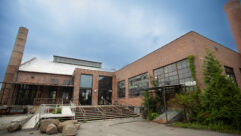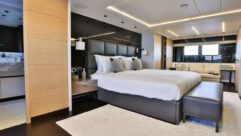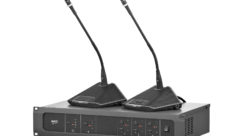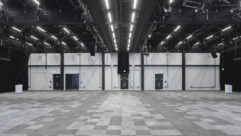Divided We Stand
May 1, 2001 12:00 PM,
Mike Safer
Divided We Stand
Versatile Audio Controller Cuts Cost ofTeleconferencing/Presentation System for Divisible Room
By MikeSafer
Coast Business Communications Inc. reduced the cost andoperational complexity of a sound system for a divisibleteleconference/presentation room. CBC designed the system around anengineered audio controller that manages all of a room’s soundsources. Generally, systems have separate controllers forteleconferencing and presentation equipment, increasing hardware costs.CBC was able to cut costs by finding a single audio controller, the ECB6 master controller from Rane Corporation, to route both telephone andprogram audio. This sound system includes two ECB 6 units to permit twosimultaneous telephone conversations when the room is divided. Aninfrared sensor alerts the control system to the position of themovable wall in the space, assessing whether there are two rooms orone, and it then manages audio inputs and outputs accordingly.
CBC was formed in 1987 to serve the audio-visual, video, andengineered sound markets. The founders, Randy Pleasance, president, andScott Kirchoff, vice president of operations, had worked together atanother contractor for 10 years. From the beginning, they based thecompany on the premise that technically superior systems are conceivedonly by technically superior engineering talent. Over the years, CBChas focused on designing and installing audio and video systems forboardrooms, training rooms, conference rooms, and for sound masking andreinforcement. Dedicated to being the technological leader, CBC employsfour engineers who specialize in audio and video system design andcontrol system software. Their services include analysis of needs,pre-construction planning, system construction and installation,training, and extended system maintenance. CBC designs and installsaudio and video systems in executive briefing centers, emergencyresponse centers, boardrooms, auditoriums, fitness centers, classroomsand customer visit centers.
Multipurpose Area
One of CBC’s clients was a major semiconductor manufacturer. Theclient wanted a state-of-the-art sound system for a multipurpose room,which was used for both teleconferencing and presentations. Undivided,the room holds approximately 65 people. A movable wall helps create tworooms in the multipurpose area, one with a 40-person capacity andanother that holds 25 people. The client wanted both sides to be ableto function independently and simultaneously, and also as one bigroom.
Because one of the functions of the room was teleconferencing, itwas necessary to equip the room with microphones as well as speakers.The client wanted the equipment built into the ceiling because the roomhad no permanently installed tables or chairs, and they did not want torun wires every time the room configuration changed. The client alsospecified that the teleconferencing system use full duplex technology,where both parties can speak at once just like using a normaltelephone. Although this is the more natural way of conducting aconversation, full duplexing can be a problem in teleconferencesituations, especially with microphones suspended from the ceiling.Delays occur because a user’s voice comes out of a ceiling speaker andthe sound from the speaker is picked up by a microphone, which sends itback to the user again. This causes the person at the far end to hearhis/her own voice in their earphone a split second after speaking. Thisis very startling and annoying, causing most people to temporarily stoptalking. Speakerphones use half-duplex technology to prevent thisproblem, but this is also unnatural because only one side of theconversation can speak at a time. The client wanted a state-of-the-artfull duplex system that would allow both parties to talk simultaneouslyand without annoying delays and feedback.
The room already had a sound system in place when CBC was hired, butno teleconference system. CBC was able to use some of the existingequipment. For example, an Axcent2 control system from AMX Corporation,Dallas, Texas, with a touch panel in each room provided a unifiedinterface making it possible to control each piece of equipment from acommon user interface. Speakers in the ceiling provided thenon-direction sound characteristic of telephone conversation andspeakers mounted at the front of each room generated directional stereosound for audio presentations from a VCR and computer. CBC alsoincorporated an existing 728PW equalizer and 884PW room combining mixerfrom Ivie Technologies, Orem, Utah, and three amplifiers from CrestAudio of Paramus, New Jersey.
Cost-Effective Base
With the goal of giving the client an advanced sound system at thebest price, CBC chose the Rane Engineered Conference System as theaudio base for the room. This system is comprised of two rack-mountedunits, the ECB 6 master controller and an ECM 8 automatic microphonemixer. It also includes RaneWare software, aMicrosoft-Windows-compatible program that provides a graphicalinterface for controlling the system and extensive on-line help. TwoTelos 1 Digital Hybrids from Telos Systems of Cleveland, Ohio, wereused to interface with the two analog telephone lines, one for eachroom.
RANE ECB 6 Base
CBC chose the Rane system for several reasons. It provided the fullduplex teleconferencing functionality the client wanted, yet was alsocapable of managing audio from other sources such as a computer or VCR.This was the only teleconferencing system they were aware of that couldalso handle other audio sources, and also had the wide frequencyresponse and low signal-to-noise ratio necessary to give the system therequired performance.
The sound system was built around two ECB 6 controllers, one foreach room. The ECB 6 units have six ports on the internal audio bridgewith each port consisting of a digitally selected 5-input audio mixer.This configuration disallows the connection of an input to its output,avoiding possible feedback. Each port input also provides for aselective automatic level control. The ECB 6 can accommodate one to sixECM 8 microphone mixers on port 1. For this divisible roomconfiguration, each ECB 6 controller is connected to its own ECM 8 micmixer. Up to eight microphones can be connected to an ECM 8 mixer. Thelarger of the two rooms contains eight microphones in the ceiling; thesmaller one has four. (The microphones were manufactured by Astatic.)The five other port inputs in the ECB 6 allow other line-level audiosignals. In these rooms, input from a computer and VCR is routed intothe ECB 6 units at ports 2 and 3. An optional plug-in card allows theECB 6 controllers to accommodate stereo inputs from these sources.
Automatic Echo Canceling
The two ECM 8 mic mixers provide digitally controlled, analog,8-channel automatic mixing. Unlike other automatic mic mixers, eachchannel is programmed as either last-on or gated output. Only channelsplaced in the last-on condition may become the master channel. In thissetting, they are also equipped with the optional Rane ECA 1 acousticecho canceller. Installation of this optional feature is a simplematter of removing the top cover of the ECM 8 and plugging the cardinto the mixer motherboard. If a model ECM 8A is ordered, the ECA 1echo canceller comes pre-installed by the factory.
RANE ECM 8 Mixer
Since the echo canceller automatically adapts, there is no need fortraining as there is with other echo canceling systems. Trainingtypically consists of broadcasting a hiss over the speakers for 15 to20 seconds. During that time, the system calibrates itself andeliminates the echo. Rane’s product continuously compensates for echoand doesn’t have to be trained. In CBC’s opinion, this is a majoradvantage since it works automatically without user intervention.
One feature the customer wanted to retain was the use of wirelesshandheld microphones during a teleconference. The audio reinforcementfrom these microphones comes out the ceiling speakers along with thevoice of the person on the other end of the telephone. The use of asystem that automatically adapts to changes in room acoustics is amajor advantage when using a wireless microphone during ateleconference.
How It Works
With the system CBC designed, the divisible conference room iscapable of functioning as one large single room or two separate rooms.Presentations and teleconferences may be held in both roomssimultaneously since each has its own audio controller, telephonehybrid and telephone line. The audio controller determines the sourceof the audio input (telephone, computer, VCR) and its volume. And itprovides output to either the ceiling speakers or the front-mountedspeakers, depending on the audio source. An infrared sensor determinesthe position of the movable wall. When the wall is open between therooms, the ECB 6 unit that normally controls the large room serves asthe master for both rooms, and calls must be initiated from the largeroom. In this configuration, the audio picked up by the small room’smicrophones is fed into the large room’s ECB 6. Conversely, audio fedto the large room’s speakers is also fed to the small room’s speakers.When the wall is closed to create two separate rooms, each roomoperates autonomously.
Design Support
In the design of this audio system, CBC received technical supportfrom Rane Corp. The AMX control system code needed to account for themoveable wall and the different room configurations was written by aRane engineer. This engineer, Mike Slattery, even traveled to the siteto get a better idea of its unique requirements.
The client also asked CBC to set up sound systems in other buildingsas well. Although none of the other facilities had a divisible room,CBC had to deal with other unusual situations, such as working in aroom with ceiling mics and very reflective surfaces on three walls.
For more information contact Rane Corporation, 10802 47th Ave West,Mukilteo, WA 98275. Phone: 425-355-6000; Fax: 425-347-7757; Web site:www.rane.com.
Mike Safer is applications engineer at Coast BusinessCommunications Inc. in Hayward, California.










